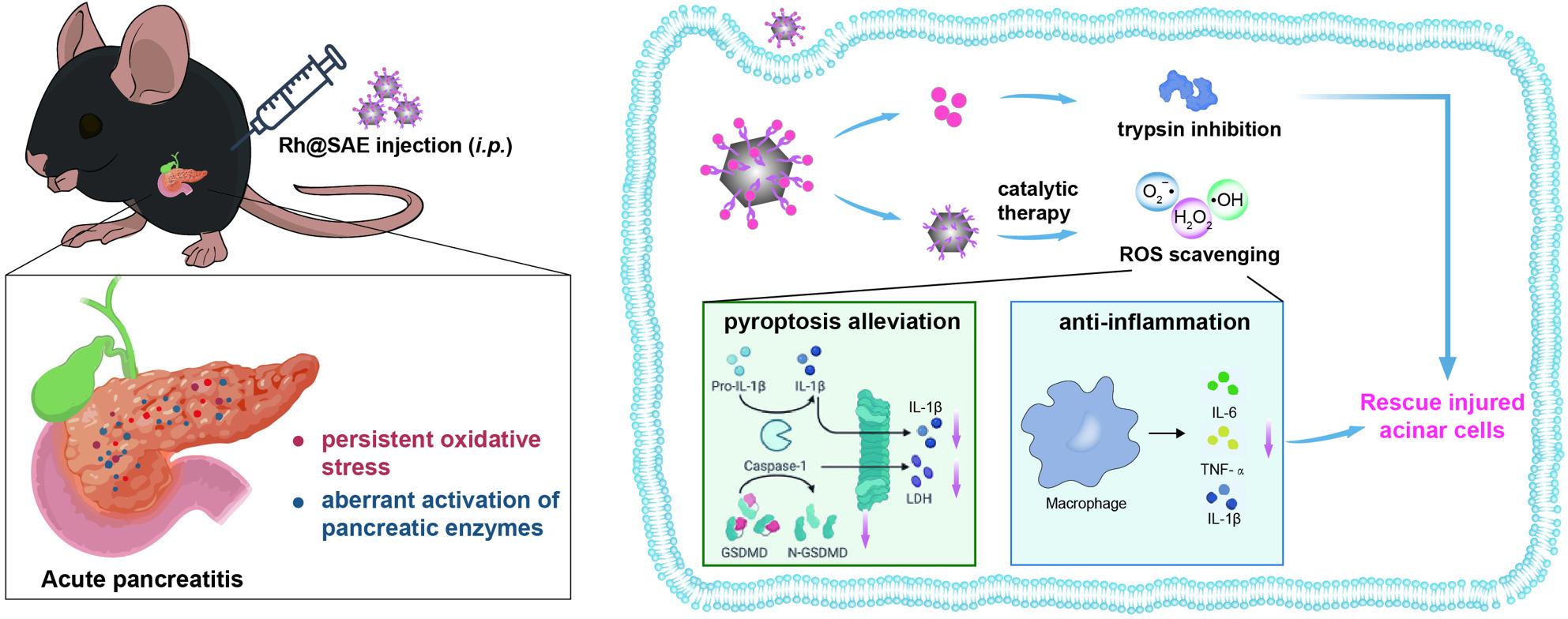Iannuzzi JP, King JA, Leong JH, Quan J, Windsor JW, Tanyingoh D, et al. Global incidence of acute pancreatitis is increasing over time: A systematic review and meta-analysis. Gastroenterology. 2022;162(1):122–34.
Google Scholar
Mederos MA, Reber HA, Girgis MD. Acute pancreatitis: a review. JAMA. 2021;325(4):382–90.
Google Scholar
Szatmary P, Grammatikopoulos T, Cai W, Huang W, Mukherjee R, Halloran C, et al. Acute pancreatitis: Diagnosis and treatment. Drugs. 2022;82(12):1251–76.
Google Scholar
Boxhoorn L, Voermans RP, Bouwense SA, Bruno MJ, Verdonk RC, Boermeester MA, et al. Acute pancreatitis. Lancet. 2020;396(10252):726–34.
Google Scholar
Lee PJ, Papachristou GI. New insights into acute pancreatitis. Nat Rev Gastroenterol Hepatol. 2019;16(8):479–96.
Google Scholar
IAP/APA evidence-based guidelines for the management of acute pancreatitis, Pancreatology official journal of the International Association of Pancreatology (IAP) et al. 2013;13:e1 15.
Hackert T, Werner J. Antioxidant therapy in acute pancreatitis: experimental and clinical evidence. Antioxid Redox Signal. 2011;15(10):2767–77.
Google Scholar
Liu L, Zhang Y, Li X, Deng J. Microenvironment of pancreatic inflammation: Calling for nanotechnology for diagnosis and treatment. J Nanobiotechnol. 2023;21(1):443.
Google Scholar
Sah RP, Garg P, Saluja AK. Pathogenic mechanisms of acute pancreatitis. Curr Opin Gastroenterol. 2012;28(5):507–15.
Google Scholar
Jakkampudi A, Jangala R, Reddy BR, Mitnala S, Reddy DN, Talukdar R, et al. NF-κb in acute pancreatitis: Mechanisms and therapeutic potential. Pancreatology. 2016;16(4):477–88.
Google Scholar
Vasudevan SO, Behl B, Rathinam VA. Pyroptosis-induced inflammation and tissue damage. Semin Immunol. 2023;69:101781.
Google Scholar
Du G, Healy LB, David L, Walker C, El-Baba TJ, Lutomski CA, et al. ROS-dependent S-palmitoylation activates cleaved and intact gasdermin D. Nature. 2024;630(8016):437–46.
Google Scholar
Ren F, Xu J, Zhang J, Xu X, Huang L, Sun W, et al. PM(2.5) induced lung injury through upregulating ROS-dependent NLRP3 inflammasome-mediated pyroptosis. Immunobiology. 2022;227(3):152207.
Google Scholar
Zhang Y, Fang C, Zhang W, Zhang K. Emerging pyroptosis-engineered nanobiotechnologies regulate cancers and inflammatory diseases: A double-edged sword. Matter. 2022;5(11):3740–74.
Google Scholar
Shi J, Gao W, Shao F. Pyroptosis: Gasdermin-mediated programmed necrotic cell death. Trends Biochem Sci. 2017;42(4):245–54.
Google Scholar
Zhou J, Fang C, Rong C, Luo T, Liu J, Zhang K. Reactive oxygen species-sensitive materials: A promising strategy for regulating inflammation and favoring tissue regeneration. Smart Mater Med. 2023;4:427–46.
Google Scholar
Zhang R, Yan X, Fan K. Nanozymes inspired by natural enzymes. Acc Mater Res. 2021;2(7):534–47.
Google Scholar
Gao L, Wei H, Dong S, Yan X. Nanozymes. Adv Mater. 2024;36(10):e2305249.
Google Scholar
Liang M, Yan X. Nanozymes: from new concepts, mechanisms, and standards to applications. Acc Chem Res. 2019;52(8):2190–200.
Google Scholar
Hai X, Xi S, Mitchell S, Harrath K, Xu H, Akl DF, et al. Scalable two-step annealing method for preparing ultra-high-density single-atom catalyst libraries. Nat Nanotechnol. 2022;17(2):174–81.
Google Scholar
Chen Y, Wang P, Hao H, Hong J, Li H, Ji S, et al. Thermal atomization of platinum nanoparticles into single atoms: An effective strategy for engineering high-performance nanozymes. J Am Chem Soc. 2021;143(44):18643–51.
Google Scholar
Hua S, Dong X, Peng Q, Zhang K, Zhang X, Yang J. Single-atom nanozymes shines diagnostics of gastrointestinal diseases. J Nanobiotechnol. 2024;22(1):286.
Google Scholar
Zhang R, Yan X, Gao L, Fan K. Nanozymes expanding the boundaries of biocatalysis. Nat Commun. 2025;16(1):6817.
Google Scholar
Li Q, Zeng M, Pu XY, Tang Q, Yang Q, Zhang LK. Melittin-Loaded Multifunctional Nanozyme for Ulcerative Colitis Treatment via Enzyme-Immunotherapy and Ferroptosis Inhibition, Advanced functional materials. 2025.
Cao F, Jin L, Gao Y, Ding Y, Wen H, Qian Z, et al. Artificial-enzymes-armed Bifidobacterium longum probiotics for alleviating intestinal inflammation and microbiota dysbiosis. Nat Nanotechnol. 2023;18(6):617–27.
Google Scholar
Chen J, Zhao Y, Ruan R, Feng X, Niu Z, Pan L, et al. Bone morphogenetic protein-2-derived peptide-conjugated nanozyme-integrated photoenhanced hybrid hydrogel for cascade-regulated bone regeneration. ACS Nano. 2025;19(15):14707–26.
Google Scholar
Li D, Ai Z, Tian Y, Wang Y, Zhang C. Bioactive prosthetic interface constructed with cascading multi-nanozyme hydrogel to induce M2 macrophage polarization and heal diabetic bone defects. Biomaterials. 2025;325:123624.
Google Scholar
Li H, Wei S, Ling Q, Wang R, Liu T, Yu H, et al. Nanozyme-reinforced hydrogel spray as a reactive oxygen species-driven oxygenator to accelerate diabetic wound healing. Adv mater (Deerfield Beach, Fla). 2025;37(34):e2504829.
Google Scholar
Xuan Q, Cai J, Gao Y, Qiao X, Jin T, Peydayesh M, et al. Amyloid-templated ceria nanozyme reinforced microneedle for diabetic wound treatments. Adv mater (Deerfield Beach, Fla). 2025;37(15):e2417774.
Google Scholar
Shan Y, Zhong J, Sun Q, Gao W, Zhang C, Chen H, et al. Dual nanozymes-loaded core-shell microneedle patches with antibacterial and NETs-degradation bifunctional properties for periodontitis treatment. Bioact Mater. 2025;53:161–77.
Google Scholar
Wang D, Jin H, Shen Y, Wang D, He J, Qu J, et al. NIR-II-activated iridium single-atom nanozymes for synergistic antibacterial therapy and tissue regeneration in MRSA-infected wounds and acute lung injury. Bioact Mater. 2025;51:543–58.
Google Scholar
Lee H, Krishnan M, Kim M, Yoon YK, Kim Y. Rhamnetin, a natural flavonoid, ameliorates organ damage in a mouse model of carbapenem-resistant acinetobacter baumannii-induced sepsis. Int J Mol Sci. 2022. https://doi.org/10.3390/ijms232112895.
Google Scholar
Novo Belchor M, Hessel Gaeta H, FabriBittencourt Rodrigues C, Ramos C, da Cruz Costa D, de Oliveira Toyama LF, et al. Evaluation of Rhamnetin as an inhibitor of the pharmacological effect of secretory phospholipase A2. Mol (Basel, Switz). 2017;22(9):1420–3049.
Google Scholar
Park ES, Kang JC, Jang YC, Park JS, Jang SY, Kim DE, et al. Cardioprotective effects of rhamnetin in H9c2 cardiomyoblast cells under H₂O₂-induced apoptosis. J Ethnopharmacol. 2014;153(3):552–60.
Google Scholar
Bull SD, Davidson MG, van den Elsen JM, Fossey JS, Jenkins AT, Jiang YB, et al. Exploiting the reversible covalent bonding of boronic acids: Recognition, sensing, and assembly. Acc Chem Res. 2013;46(2):312–26.
Google Scholar
Geng W, Jiang N, Qing GY, Liu X, Wang L, Busscher HJ, et al. Click reaction for reversible encapsulation of single yeast cells. ACS Nano. 2019;13(12):14459–67.
Google Scholar
Zhang K, Cheng Y, Ren W, Sun L, Liu C, Wang D, et al. Coordination-responsive longitudinal relaxation tuning as a versatile MRI sensing protocol for malignancy targets. Adv Sci. 2018;5(9):1800021.
Google Scholar
Yu P, Zhang X, Liu N, Tang L, Peng C, Chen X. Pyroptosis: Mechanisms and diseases. Signal Transduct Target Ther. 2021;6(1):128.
Google Scholar









